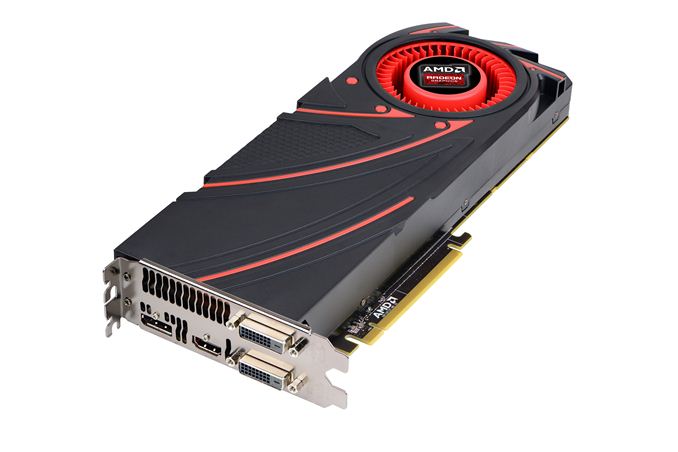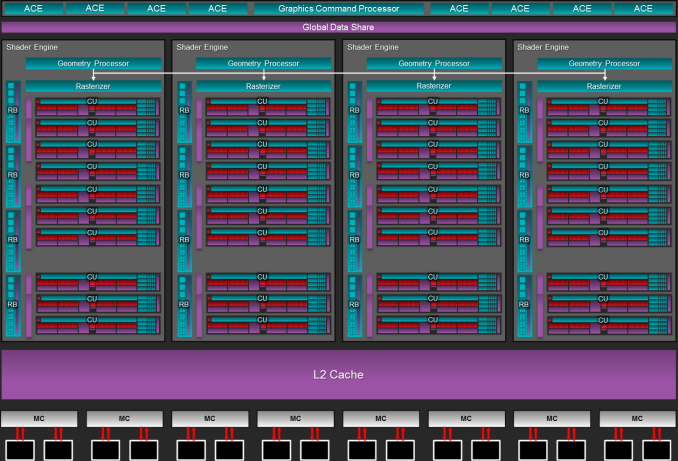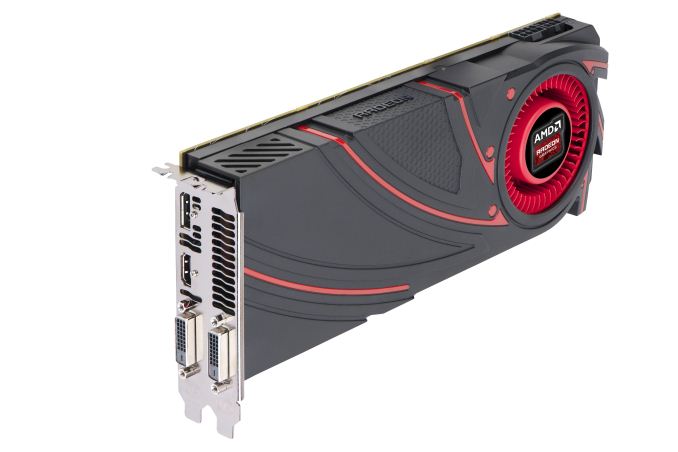The AMD Radeon R9 290 Review
by Ryan Smith on November 5, 2013 12:01 AM EST- Posted in
- GPUs
- AMD
- Radeon
- Hawaii
- Radeon 200

With the launch of AMD’s Radeon R9 290X less than 2 weeks ago, the video card marketplace has become very active very quickly. The 290X not only reasserted AMD’s right to fight for the video card performance crown, but in doing so it has triggered an avalanche of pricing and positioning changes that have affected both NVIDIA and AMD.
NVIDIA for their part cut the price of the GTX 780 and GTX 770 to $500 and $330 respectively, repositioning the cards and giving them their first official price cuts since their spring launches. Meanwhile AMD has also made some changes, and although 290X is unaffected for the moment, 290 was affected before it even launched, receiving an arguably significant specification adjustment. Consequently with GTX 780’s price cut being NVIDIA’s counter to 290X, 290 has gone from just being a lower tier Hawaii card to also being AMD’s counter-counter, and in the process has become a somewhat different card than what it was going to be just one week ago.
But before we get ahead of ourselves, let’s start at the beginning. With the successful launch of the 290X behind them, and the equally successful launch of their new flagship GPU Hawaii, AMD is ready to make their next move. Launching today will be the Radeon R9 290, the obligatory lower-tier part for AMD’s new flagship lineup. Making the usual tradeoffs for a lower-tier part, AMD is cutting down on both the number of functional units and the clockspeeds, the typical methods for die harvesting, in exchange for a lower price. Now officially AMD has not announced the Radeon R9 290 in advance, but with listings for it having already gone up on the same day as the 290X, it’s something that everyone has been expecting.
As always we’ll offer a full breakdown of performance and other attributes in the following pages, but before we even begin with that we want to point out that the 290 is going to be one of AMD’s most controversial and/or hotly debated launches in at least a couple of years. The merits of 290X were already hotly debated in some gaming circles for its noise relative to its performance and competition, and unfortunately 290 is going to be significantly worse in that respect. We’ll have a full rundown in the following pages, but in a nutshell AMD has thrown caution into the wind in the name of maximizing performance.
| AMD GPU Specification Comparison | ||||||
| AMD Radeon R9 290X | AMD Radeon R9 290 | AMD Radeon R9 280X | AMD Radeon HD 7970 | |||
| Stream Processors | 2816 | 2560 | 2048 | 2048 | ||
| Texture Units | 176 | 160 | 128 | 128 | ||
| ROPs | 64 | 64 | 32 | 32 | ||
| Core Clock | 727MHz | 662MHz | 850MHz | 925MHz | ||
| Boost Clock | 1000MHz | 947MHz | 1000MHz | N/A | ||
| Memory Clock | 5GHz GDDR5 | 5GHz GDDR5 | 6GHz GDDR5 | 5.5GHz GDDR5 | ||
| Memory Bus Width | 512-bit | 512-bit | 384-bit | 384-bit | ||
| VRAM | 4GB | 4GB | 3GB | 3GB | ||
| FP64 | 1/8 | 1/8 | 1/4 | 1/4 | ||
| TrueAudio | Y | Y | N | N | ||
| Transistor Count | 6.2B | 6.2B | 4.31B | 4.31B | ||
| Typical Board Power | ~300W (Unofficial) | ~300W (Unofficial) | 250W | 250W | ||
| Manufacturing Process | TSMC 28nm | TSMC 28nm | TSMC 28nm | TSMC 28nm | ||
| Architecture | GCN 1.1 | GCN 1.1 | GCN 1.0 | GCN 1.0 | ||
| GPU | Hawaii | Hawaii | Tahiti | Tahiti | ||
| Launch Date | 10/24/13 | 11/05/13 | 10/11/13 | 12/28/11 | ||
| Launch Price | $549 | $399 | $299 | $549 | ||
Diving right into the hardware specifications, Radeon R9 290 is a bit more powerful than usual for a lower-tier part. AMD has cut the number of CUs from 44 to 40 – disabling 1 CU per SE – while adjusting down the base GPU clockspeed and boost GPU clockspeed to from 727MHz and 1000MHz to 662MHz and 947MHz respectively. However AMD has not cut the amount of memory, the memory clockspeed, the memory bus width, or the number of ROPs, leaving those at 5GHz for the memory clockspeed, 512-bits for the memory bus width, and all 64 ROPs for the back-end hardware.
As a result the differences between the 290 and 290X are on paper limited entirely to the clockspeed differences and the reduced number of CUs. At their top boost bins this gives 290 95% the clockspeed of 290X, and 91% of the shader hardware, giving 290 100% of 290X’s memory performance, 95% of 290X’s ROP and geometry performance, and 86% of 290X’s shading/texturing performance.
Compared to AMD’s last generation offerings, the 290 is going to be closer to 290X than 7950 was to 7970. 290 retains a larger percentage of 290X’s shader and ROP performance, never mind the fact that the full 320GB/sec of memory bandwidth is being retained. As such despite the wider price difference this time around, performance on paper is going to be notably closer. Paper will of course be the key word here, as in the case of 290 more so than any other card we’ve looked at in recent history theory and practice will not line up. Compared to the 290X, practice will be favoring the 290 by far.
Moving on to power consumption, perhaps because of AMD’s more aggressive specifications for their lower-tier card this time around, power consumption is not dropping at all. AMD is still not throwing us any useful hard numbers, but based on our performance data we estimate the 290 to have a nearly identical TDP to the 290X, leading us to keep it at an unofficial 300W. Lower-tier parts typically trade performance for power consumption, but that will not be the case here. Power consumption will be identical while performance will be down, so efficiency will be slipping and 290 will have all the same power/cooling requirements as 290X.
Meanwhile like the 290X launch, the 290 launch is going to be a hard launch, and a full reference launch at that. As such we’ll be seeing 290 cards go up for sale at the usual retailers today, with all of those cards using AMD’s reference cooler and reference board, itself unchanged from the 290X.
As for pricing and competitive positioning, AMD will be launching the 290 at what we consider to be a very aggressive price of $399. Based on the initial specifications, the performance, and the competition, we had been expecting AMD to launch this at $449, mirroring the launch of the 7950 in the process. But AMD has gone one step further by significantly undercutting both themselves and NVIDIA.
290’s immediate competition on the AMD side will be the $549 290X above it and the $299 280X below it, while on the NVIDIA side the competition will be the $499 GTX 780 above it and the $329 GTX 770 below it. Pricing wise this puts 290 as closer competition to 280X/GTX 770 than it does the high-tier cards, but as we’ll see in our benchmarks AMD is aiming for the top with regards to performance, which will make price/performance comparisons both interesting and frustrating at the same time.
NVIDIA for their part will have their 3 game Holiday GeForce Bundle on the GTX 780 and GTX 770, presenting the same wildcard factor for overall value that we saw with the 290X launch. As always, the value of bundles are ultimately up to the buyer, especially in this case since we’re looking at a rather significant $100 price gap between the 290 and the GTX 780.
| Fall 2013 GPU Pricing Comparison | |||||
| AMD | Price | NVIDIA | |||
| Radeon R9 290X | $550 | ||||
| $500 | GeForce GTX 780 | ||||
| Radeon R9 290 | $400 | ||||
| $330 | GeForce GTX 770 | ||||
| Radeon R9 280X | $300 | ||||
| $250 | GeForce GTX 760 | ||||
| Radeon R9 270X | $200 | ||||
| $180 | GeForce GTX 660 | ||||
| $150 | GeForce GTX 650 Ti Boost | ||||
| Radeon R7 260X | $140 | ||||












295 Comments
View All Comments
TheJian - Tuesday, November 5, 2013 - link
Simple economics...NV doesn't make as much as they did in 2007. They are not gouging anyone and should be charging more (so should AMD) and neither side should be handing out free games. Do you want them to be able to afford engineers and good drivers or NOT? AMD currently can't afford them due to your price love, so you get crap drivers that still are not fixed. It's sad people don't understand the reason you have crap drivers is they have lost $6Billion in 10yrs! R&D isn't FREE and the king of the hill gets to charge more than the putz. Why do you think their current card is 10db’s higher in noise, 50-70 watts higher and far hotter? NO R&D money.NV made ~550mil last 12 months (made $850 in 2007). Intel made ~10Billion (made under 7B 2007, so profits WAY UP, NV way down). Also INtel had 54B in assets 2007, now has 84billion! Who's raping you? The Nvidia hate is hilarious. I like good drivers, always improving products, and new perf/features. That means they need to PROFIT or we'll get crappy drivers from NV also.
Microsoft 2007=14B, this year $21B (again UP HUGE!)
Assets 2007=64B, 2013=146Billion HOLY SHITE.
Who's raping you...IT isn't Nvidia...They are not doing nearly as well as 2007. So if they were even raping you then, now they're just asking you to show them your boobs...ROFL. MSFT/INtel on the other hand are asking you to bend over and take it like a man, oh and give me your wallet when I'm done, hey and that car too, heck sign over your house please...
APPLE 2007=~3Bil profits 2013=41Billion (holy 13.5x the raping).
Assets 2007=25B, wait for it...2013=176Billion!
bend over and take it like a man, oh and give me your wallet when I'm done, hey and that car too, heck sign over your house please...Did you mention you're planning on having kids?...Name them Apple and I want them as slaves too...LOL
Are we clear people. NV makes less now than 2007 and hasn't made near that 850mil since. Why? Because market forces are keeping them down which is only hurting them, and their R&D (that force is AMD, who by the way make ZERO). AMD is killing themselves and fools posting crap like this is why (OK, it's managements fault for charging stupidly low prices and giving out free games). You can thank the price of your card for your crappy AMD drivers
Doesn't anyone want AMD to make money? Ask for HIGHER PRICES! Not lower, and quit demonizing NV (or AMD) who doesn't make NEAR what they did in 2007! Intel killed their chipset business and cost them a few hundred million each year. See how that works. If profits for these two companies don't start going up we're all going to get slower product releases (witness what just happened, no new cards for 2yrs if you can even call AMD's new as it just catches OLD NV cards and runs hot doing it), and we can all expect CRAP DRIVERS with those slower released cards.
AMD finally made a profit in the last year 1/2 this Q (only 48mil and less depending on if you look gaap, non-gaap). AMD has lost over 6Billion in 10yrs. They are not charging you enough. I expect them to lose money again as they owe $200mil to GF Dec 31st which will wipe out last Q profit and kill this Q also. See the point? They need to make money. How is it possible for either side to be ripping us off if neither has made as much as they did in 2007 for 6 years with AMD losing their collective ARSE?
I could give you the Hard Drive makers profits etc and would show the same (or worse) as MS, Apple, Google. The flood allowed them all triple profits (quad in Seagates case). YES, this is ripping us off.
Spunjji - Tuesday, November 5, 2013 - link
TL;DRSenti - Tuesday, November 5, 2013 - link
Good drivers from NV? Ha-ha-ha! You've never run anything besides few overhyped games I guess. They are awful the moment you start programming them:You use some obscure feature of standard that is not used in games? Here, have a bluescreen! Even AMD video drivers weren't so bad recently.
File in bug report? Ignored, who cares about you, you are not making one of top tier games.
Want OpenCL 1.2 like the rest of the world has (even integrated Intel videocards)? No, it's not important – here you are ten new versions of CUDA!
And how about crippled OpenGL for non-Quadro cards? Sure I know what I'm talking about since I have Quadro too.
dragonsqrrl - Monday, November 11, 2013 - link
Your comment is nothing but an exercise in ambiguity. So basically what you're saying is that because Nvidia's drivers don't work perfectly for every user, AMD's drivers are superior. Really?The one sentence that's actually applicable to gaming is just about as vague as you can get, maybe because you don't actually know what you're talking about? Bluescreen, really? Okay... And from an end user perspective wtf does it even mean to program a driver? Are you suggesting you're something more than an end user? Are you suggesting you work for Nvidia? lol...
Whatever driver related bsod problems you were having is unlikely to be systemic, and may not even be driver related at all. Almost all of the Nvidia driver issues I've read about in recent memory (past couple of years) have been isolated incidents that may result in instability for certain users, none of which I've experienced myself (GTX480). Optimizations compared to the competition have been spot on, and title support has been fantastic. The only exception I can think of was the fan controller issue a couple years ago. Compare that to AMD's recent driver issues (xfire, surround, 4k, frame pacing, etc), all of which are systemic and widespread. I think most AMD fanboys choose to either ignore these problems, or accept them as the norm (same with fan noise on stock coolers), which is stupid and self defeating in my opinion. That sort of attitude doesn't drive AMD or Nvidia to improve.
Senti - Wednesday, November 13, 2013 - link
I'm talking from developer's point, can you even read? You probably have no clue about programming if those sounded ambiguous and you even suggested that I work for NV, lol.I don't say that AMD's drivers are superior, but I can surely say that "NV drivers are superior" is one big lie. They are both bad, really.
I can tell you some fun things about AMD's drivers too: like, uploading textures of certain sizes crashes them, or how their OpenCL compiler crashes on certain C99 features. But those are just program-level crashes (not system-level) and I see texture crash only in recent beta versions, not the last stable version; haven't really investigated OpenCL ones. On the other hand I can reliably send NV drivers into bluescreen, but as already said, it's quite obscure feature and simple users have very low chance to stumble upon it.
Conclusion: we do love AMD for their performance/price ratio while there is nothing to love NV for except being mindless fanboy. My personal view of current situation, feel free to disagree.
nsiboro - Wednesday, November 6, 2013 - link
TL;DRNvidia isn't doing only GPU. Do not forget Tegra - acquisition of comm IP, etc. do require $$$.
The raping is true.
GPU revenue dump into ARM/mobile for future survival.
Drumsticks - Tuesday, November 5, 2013 - link
I like how they actually explicitly recommend against the card and the first 5 comments are praising it XD.That's a LOT of noise... but when we get custom coolers this will be really, really exciting.
RussianSensation - Tuesday, November 5, 2013 - link
Yup, customs coolers will fix both the noise levels and temperature issues. After that, this card will be a must buy. 2 Windforce 3x (dual slot) and $699 780Ti is irrelevant. In fact, after-market versions of R9 290 will make 780/R9 290X and 780Ti very overpriced. They can't get here soon enough.dragonsqrrl - Tuesday, November 5, 2013 - link
Well, sometimes you just can't fix fanboism.Tetracycloide - Tuesday, November 5, 2013 - link
How puerile.